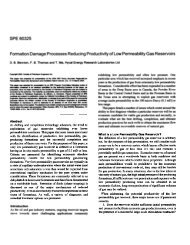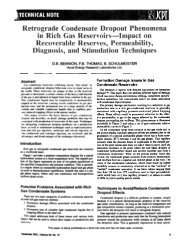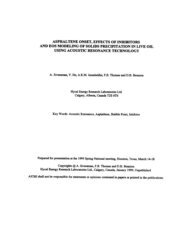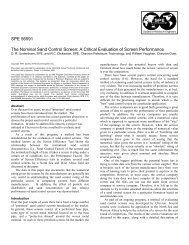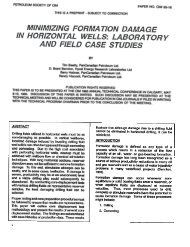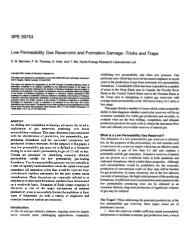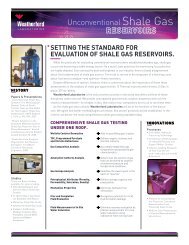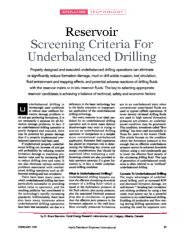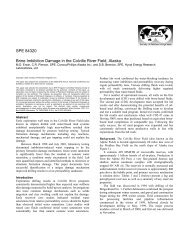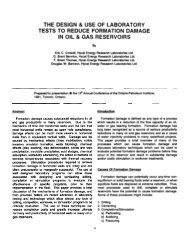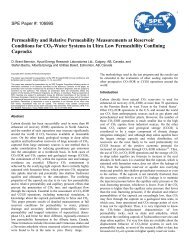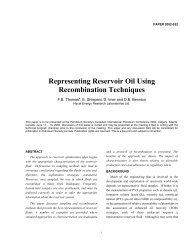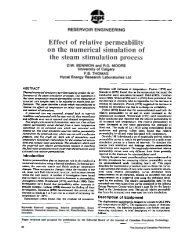The Influence of Wettability on Petrophysical Properties
The Influence of Wettability on Petrophysical Properties
The Influence of Wettability on Petrophysical Properties
- No tags were found...
Create successful ePaper yourself
Turn your PDF publications into a flip-book with our unique Google optimized e-Paper software.
SCA2009-A84 1/6<str<strong>on</strong>g>The</str<strong>on</strong>g> <str<strong>on</strong>g>Influence</str<strong>on</strong>g> <str<strong>on</strong>g>of</str<strong>on</strong>g> <str<strong>on</strong>g>Wettability</str<strong>on</strong>g> <strong>on</strong> <strong>Petrophysical</strong> <strong>Properties</strong>Saif Alsayari 1 , Moustafa Dernaika 2 and Martin J Blunt 11 Department <str<strong>on</strong>g>of</str<strong>on</strong>g> Earth Science and Engineering, Imperial College L<strong>on</strong>d<strong>on</strong>, UK2 Weatherford Laboratories, EL ResLab, Abu Dhabi, UAEProceedings <str<strong>on</strong>g>of</str<strong>on</strong>g> the Internati<strong>on</strong>al Symposium <str<strong>on</strong>g>of</str<strong>on</strong>g> theSociety <str<strong>on</strong>g>of</str<strong>on</strong>g> Core Analysts held in Noordwijk aan Zee, <str<strong>on</strong>g>The</str<strong>on</strong>g> Netherlands 27-30 September, 2009ABSTRACTWe measured capillary pressure, relative permeability, electrical resistivity and NMRresp<strong>on</strong>se <strong>on</strong> carb<strong>on</strong>ate samples from a producing field in the Middle East. <str<strong>on</strong>g>The</str<strong>on</strong>g> porethroat distributi<strong>on</strong> from mercury injecti<strong>on</strong> was successfully compared with the pore sizedistributi<strong>on</strong> inferred from the NMR T 2 relaxati<strong>on</strong> curve. Some samples were aged incrude oil at elevated temperature and underwent the same experiments to evaluate theinfluence <str<strong>on</strong>g>of</str<strong>on</strong>g> wettability changes <strong>on</strong> these properties.<str<strong>on</strong>g>The</str<strong>on</strong>g> experimental data show that there is a significant difference in the relativepermeability and capillary pressure <str<strong>on</strong>g>of</str<strong>on</strong>g> clean and aged samples; the results are explainedin terms <str<strong>on</strong>g>of</str<strong>on</strong>g> the pore-scale c<strong>on</strong>figurati<strong>on</strong>s <str<strong>on</strong>g>of</str<strong>on</strong>g> fluids. In c<strong>on</strong>trast, electrical resistivity didnot encounter significant changes for different wettability, suggesting that electricalproperties in these carb<strong>on</strong>ates are mainly affected by the porosity that remains waterwet,or is <strong>on</strong>ly neutrally-wet. This c<strong>on</strong>clusi<strong>on</strong> is supported by the significantdisplacement that is observed in the aged sample at capillary pressures close to zero.INTRODUCTIONMany wettability studies have been c<strong>on</strong>ducted <strong>on</strong> sandpacks and sandst<strong>on</strong>es to examinethe optimum wettability state for fluid recovery in hydrocarb<strong>on</strong> reservoirs. Reviews <str<strong>on</strong>g>of</str<strong>on</strong>g>the effects <str<strong>on</strong>g>of</str<strong>on</strong>g> wettability <strong>on</strong> petrophysical properties can be found in [1-6]. In carb<strong>on</strong>atesamples studies, opini<strong>on</strong> varies widely <strong>on</strong> whether str<strong>on</strong>gly oil-wet [7], str<strong>on</strong>gly waterwet[8-10] or intermediate-wet [11,12] c<strong>on</strong>diti<strong>on</strong>s are optimal for waterflood recovery.This ambiguity is principally due to the scarcity <str<strong>on</strong>g>of</str<strong>on</strong>g> good-quality experimental data.Furthermore, the heterogeneity <str<strong>on</strong>g>of</str<strong>on</strong>g> carb<strong>on</strong>ate pore geometry makes it difficult to assignan inferred wettability accurately. Previous studies in the literature have tended to focus<strong>on</strong> either experimental measurement <str<strong>on</strong>g>of</str<strong>on</strong>g> <strong>on</strong>e property or simulati<strong>on</strong> studies. In this work,we will measure a range <str<strong>on</strong>g>of</str<strong>on</strong>g> properties <strong>on</strong> a benchmark series <str<strong>on</strong>g>of</str<strong>on</strong>g> carb<strong>on</strong>ate cores <str<strong>on</strong>g>of</str<strong>on</strong>g>different wettability.EXPERIMENTAL MATERIALS, APPARATUS AND PROCEDUREExperimental materials<str<strong>on</strong>g>The</str<strong>on</strong>g> reservoir core samples were 0.038 m in diameter and had porosity ranging from 22-32% and permeability ranging from 0.2-1.1x10 -13 m 2 . <str<strong>on</strong>g>The</str<strong>on</strong>g> lith<str<strong>on</strong>g>of</str<strong>on</strong>g>acies <str<strong>on</strong>g>of</str<strong>on</strong>g> this resevoir isknown to be a skeletal, peloid packst<strong>on</strong>e. <str<strong>on</strong>g>The</str<strong>on</strong>g> brine used throughout the displacementexperiments was de-i<strong>on</strong>ized water, with different percentages <str<strong>on</strong>g>of</str<strong>on</strong>g> NaCl, CaCl 2 , MgCl 2 ,Na 2 SO 4 and NaHCO 3 . <str<strong>on</strong>g>The</str<strong>on</strong>g> density <str<strong>on</strong>g>of</str<strong>on</strong>g> the brine used for the experiments was 1128 kg/m 3and resistivity <str<strong>on</strong>g>of</str<strong>on</strong>g> 0.051 ohm.m. Isopar-L was the oil used. <str<strong>on</strong>g>The</str<strong>on</strong>g> density <str<strong>on</strong>g>of</str<strong>on</strong>g> isopar-L at 15o C is 765 kg/m 3 . Dead crude oil from the same producing field was used to alter thewettability <str<strong>on</strong>g>of</str<strong>on</strong>g> the samples.
SCA2009-A84 2/6Experimental apparatus and procedure<str<strong>on</strong>g>The</str<strong>on</strong>g> samples underwent standard soxhlet cleaning using toluene and methanol toremove water, oil and salts. <str<strong>on</strong>g>The</str<strong>on</strong>g>n, the samples were loaded in core holders and flushcleaning was commenced using series <str<strong>on</strong>g>of</str<strong>on</strong>g> hot miscible cycles <str<strong>on</strong>g>of</str<strong>on</strong>g> toluene, a mixture <str<strong>on</strong>g>of</str<strong>on</strong>g>toluene and methanol and methanol. <str<strong>on</strong>g>The</str<strong>on</strong>g>n c<strong>on</strong>venti<strong>on</strong>al and special core analysescommenced. <str<strong>on</strong>g>The</str<strong>on</strong>g> apparatus used for the c<strong>on</strong>venti<strong>on</strong>al core analysis, NMR and electricalmeasurements are similar to those described in the literature [1-6].Steady-state relative permeabilityA core plug (sample 1) at initial water saturati<strong>on</strong> is flooded with brine and oil at aspecified fracti<strong>on</strong>al flow. <str<strong>on</strong>g>The</str<strong>on</strong>g> flooding is c<strong>on</strong>tinued until equilibrium is reached (steadystate). After reaching equilibrium, the fracti<strong>on</strong>al flow <str<strong>on</strong>g>of</str<strong>on</strong>g> water is increased. <str<strong>on</strong>g>The</str<strong>on</strong>g> totalrate (sum <str<strong>on</strong>g>of</str<strong>on</strong>g> the oil and water rate) is kept c<strong>on</strong>stant. At each steady state, the flow-rate,differential pressure, temperature and saturati<strong>on</strong> fracti<strong>on</strong> for each phase in the core plugwere recorded, from which the relative permeability is calculated using Darcy’s Law.<str<strong>on</strong>g>The</str<strong>on</strong>g>n, the core plug was cleaned, saturated with brine and flooded with crude oil at 110o C. When no more water was produced the sample was kept in the crude oil at 110 o Cfor forty days to allow the alterati<strong>on</strong> <str<strong>on</strong>g>of</str<strong>on</strong>g> wettability. <str<strong>on</strong>g>The</str<strong>on</strong>g>n, the relative permeabilityexperiment was repeated <strong>on</strong> this aged sample.Capillary pressure and resistivity index by the porous plate techniqueWater-wet ceramic plates were installed in the bottom <str<strong>on</strong>g>of</str<strong>on</strong>g> the cleaned and brine saturatedsamples 4 and 5. <str<strong>on</strong>g>The</str<strong>on</strong>g> core plugs were de-saturated using mineral oil by increasing thecapillary pressure in steps and recording resistivity at each saturati<strong>on</strong> step (Drainagecurve). Sample 4 was then separated from the apparatus and the mineral oil wasdisplaced by crude oil. <str<strong>on</strong>g>The</str<strong>on</strong>g> sample was kept in oven at 110 o C for forty days.Afterwards, the crude oil was displaced by decalin buffer (to prevent asphalteneprecipitati<strong>on</strong>) followed by mineral oil and the experiment was performed as above.At the highest capillary pressure, the plugs were allowed to imbibe brine sp<strong>on</strong>taneously(positive capillary pressure) at ambient temperature and net overburden pressure (2650psi). After attaining equilibrium data (stable water reading and stable resistivity) at zerocapillary pressure, the water valves were shut. <str<strong>on</strong>g>The</str<strong>on</strong>g> c<strong>on</strong>fining pressure was thencarefully lowered to zero allowing the sample to admit oil slowly to fill the increasingpore volume. <str<strong>on</strong>g>The</str<strong>on</strong>g> porous plate was then removed and an oil-wet porous plate saturatedwith laboratory oil was installed. <str<strong>on</strong>g>The</str<strong>on</strong>g> samples were then saturated with brine by forcingwater into the samples. This was achieved by increasing the water pressure over the oilpressure and the capillary pressure becomes negative; capillary pressure was decreasedin steps and resistivity and volume <str<strong>on</strong>g>of</str<strong>on</strong>g> brine were recorded at each saturati<strong>on</strong> step.RESULTSC<strong>on</strong>venti<strong>on</strong>al core analysisTable 1 shows the measured porosity and permeability for the five carb<strong>on</strong>ate samplesstudied. Excellent was found for porosity and permeability measured using differenttechniques: c<strong>on</strong>venti<strong>on</strong>al analysis <strong>on</strong> plugs (helium gas expansi<strong>on</strong> porosity and nitrogengas permeability), NMR and mercury analysis <strong>on</strong> trims.
SCA2009-A84 3/6Mercury injecti<strong>on</strong> capillary pressureMercury injecti<strong>on</strong> capillary pressure data has been measured for clean dry trims fromeach sample using a Micromeritics Autopore IV 9520. Figure 2 shows the measureddrainage capillary pressure and inferred throat size distributi<strong>on</strong> from these curves. Notethat most <str<strong>on</strong>g>of</str<strong>on</strong>g> the throat diameters are around 1 μm.NMR results compared to mercury injecti<strong>on</strong> dataFigure 2 (a-e) compares the pore diameter derived from the NMR resp<strong>on</strong>se to the throatsize distributi<strong>on</strong> from the mercury injecti<strong>on</strong> capillary pressure. <str<strong>on</strong>g>The</str<strong>on</strong>g> two ways toestimate pore size are in good agreement, again c<strong>on</strong>firming that the majority <str<strong>on</strong>g>of</str<strong>on</strong>g> the porespace has an effective radius less than 1 μm. <str<strong>on</strong>g>The</str<strong>on</strong>g> relative positi<strong>on</strong> <str<strong>on</strong>g>of</str<strong>on</strong>g> the T 2 distributi<strong>on</strong><strong>on</strong> the pore diameter axis is altered by changing a scaling factor (Figure 3f). <str<strong>on</strong>g>The</str<strong>on</strong>g> scalingfactor has the unit micr<strong>on</strong>s/millisec<strong>on</strong>d. <str<strong>on</strong>g>The</str<strong>on</strong>g> scaling factor can be used to c<strong>on</strong>vert T 2times to pore diameter. <str<strong>on</strong>g>The</str<strong>on</strong>g> comparis<strong>on</strong> is optimized by changing the scaling factor toobtain the best match between the mercury injecti<strong>on</strong> and T 2 distributi<strong>on</strong> curves.<str<strong>on</strong>g>The</str<strong>on</strong>g> measured samples in general, show an excellent match between T 2 distributi<strong>on</strong>s andmercury injecti<strong>on</strong> pore size distributi<strong>on</strong>s. <str<strong>on</strong>g>The</str<strong>on</strong>g> NMR experiments were c<strong>on</strong>ducted <strong>on</strong> thewhole plug, and capillary pressure was measured <strong>on</strong> an end-cap. <str<strong>on</strong>g>The</str<strong>on</strong>g> agreement in theresults indicates homogeneous samples.Capillary pressure and resistivity indexFigure 3 shows the measured capillary pressure and resisitivity indices for cleaned andaged samples 5 and 4, respectively. For primary drainage the capillary pressure curvesare similar and comparable to that measured using mercury injecti<strong>on</strong> (the assumedair/mercury c<strong>on</strong>tact angle used is 130˚, and the air/mercury interfacial tensi<strong>on</strong> is 485mN/m.). <str<strong>on</strong>g>The</str<strong>on</strong>g> irreducible water saturati<strong>on</strong> for these samples is very low – <strong>on</strong>ly around5%. For the cleaned sample 5, approximately half the water displacement issp<strong>on</strong>taneous, with a positive capillary pressure, while half required forced injecti<strong>on</strong> witha residual oil saturati<strong>on</strong> <str<strong>on</strong>g>of</str<strong>on</strong>g> around 25%. This indicates that the samples are not str<strong>on</strong>glywater-wet but display intermediate characteristics, even when cleaned. <str<strong>on</strong>g>The</str<strong>on</strong>g> aged sample4, shows a small amount <str<strong>on</strong>g>of</str<strong>on</strong>g> sp<strong>on</strong>taneous displacement <str<strong>on</strong>g>of</str<strong>on</strong>g> oil by water – around 5% –which may indicate some pores remain water-wet despite ageing. However, mostrecovery occurs during forced displacement. Most recovery is achieved for capillarypressures close to zero, indicating that much <str<strong>on</strong>g>of</str<strong>on</strong>g> the pore space is neutrally-wet witheffective c<strong>on</strong>tact angles close to 90 o . This is evidently not a uniformly and str<strong>on</strong>gly oilwetsample. <str<strong>on</strong>g>The</str<strong>on</strong>g> residual oil saturati<strong>on</strong> – around 20% - is lower than for the water-wetsystem, as seen in other aged samples; this is likely to be due to the slow drainage <str<strong>on</strong>g>of</str<strong>on</strong>g> oillayers in an oil-wet system [4, 7, 13].A surprising result is that the resistivity indices <str<strong>on</strong>g>of</str<strong>on</strong>g> the cleaned and aged systems aresimilar. This indicates that perhaps the electrical properties are dominated by porositythat remains water-wet or at least neutrally-wet – the capillary pressure curve for theaged sample, showing some sp<strong>on</strong>taneous imbibiti<strong>on</strong> and displacement at a low capillarypressure would support this c<strong>on</strong>clusi<strong>on</strong>.Relative permeability curves<str<strong>on</strong>g>The</str<strong>on</strong>g> cleaned and saturated sample 1 was drained to initial water saturati<strong>on</strong> using theporous plate technique. <str<strong>on</strong>g>The</str<strong>on</strong>g> cleaned core had a slightly higher initial water saturati<strong>on</strong>
SCA2009-A84 4/6(12%) than the aged sample (8%) – this is c<strong>on</strong>sistent with wettability change, allowingdisplacement <str<strong>on</strong>g>of</str<strong>on</strong>g> water from the less water-wet sample.Figure 4 compares the steady-state relative permeabilities for the cleaned and then agedsample 1. As expected, after aging, the oil relative permeability at the same saturati<strong>on</strong> islower than for a water-wet sample: in water-wet media, oil occupies the larger porespaces, while in oil-wet systems; it preferentially occupies smaller pores or layers withlow c<strong>on</strong>ductivity. <str<strong>on</strong>g>The</str<strong>on</strong>g> water relative permeability is larger, since, in oil-wet media, thewater displaces oil from the larger pore spaces. <str<strong>on</strong>g>The</str<strong>on</strong>g> residual oil saturati<strong>on</strong> for thecleaned case is 0.23. <str<strong>on</strong>g>The</str<strong>on</strong>g> end-point water relative permeability – 0.32 – is quite high,indicating that the system is not str<strong>on</strong>gly water-wet, as discussed previously. For theaged system, the steady-state technique was unable to probe the regime where the oilrelative permeability is very low, giving an apparent residual <str<strong>on</strong>g>of</str<strong>on</strong>g> 0.5: in reality oil willc<strong>on</strong>tinue to flow down to much lower saturati<strong>on</strong> through the slow drainage <str<strong>on</strong>g>of</str<strong>on</strong>g> layers asindicated by the capillary pressure measurements.CONCLUSIONSWe have c<strong>on</strong>ducted a series <str<strong>on</strong>g>of</str<strong>on</strong>g> measurements <strong>on</strong> cleaned and aged carb<strong>on</strong>ate cores.NMR and mercury injecti<strong>on</strong> capillary pressure measurements gave c<strong>on</strong>sistent estimates<str<strong>on</strong>g>of</str<strong>on</strong>g> the pore size distributi<strong>on</strong>. <str<strong>on</strong>g>The</str<strong>on</strong>g> cleaned cores appeared to be weakly water-wet, withapproximately half the waterflood recovery achieved by forced displacement. <str<strong>on</strong>g>The</str<strong>on</strong>g> agedsamples showed some displacement by sp<strong>on</strong>taneous imbibiti<strong>on</strong> and c<strong>on</strong>siderabledisplacement at a very low capillary pressure. <str<strong>on</strong>g>The</str<strong>on</strong>g> resistivity indices showed littledifference between cleaned and aged samples, indicating that the c<strong>on</strong>ductance isdominated by water in water-wet or neutrally-wet pores. This suggests that resistivityal<strong>on</strong>e is not a good indicator <str<strong>on</strong>g>of</str<strong>on</strong>g> wettability. <str<strong>on</strong>g>The</str<strong>on</strong>g> cleaned samples gave relativepermeabilities also c<strong>on</strong>sistent with a weakly water-wet system, while the aged core hashigher water and lower oil relative permeabilities indicating oil-wet characteristics.It is well known that the vast majority <str<strong>on</strong>g>of</str<strong>on</strong>g> carb<strong>on</strong>ates reservoirs are not water-wet [14];however, these studies were performed primarily <strong>on</strong> fields in the US with heavy oils. Inthe present paper, the wettability <str<strong>on</strong>g>of</str<strong>on</strong>g> a typical Middle East carb<strong>on</strong>ate reservoir isthoroughly investigated. We suggest that the typical wettability <str<strong>on</strong>g>of</str<strong>on</strong>g> Middle East fields isnot str<strong>on</strong>gly oil-wet, but shows mixed-wet and neutrally-wet characteristics. This resultis c<strong>on</strong>sistent with recent studies performed <strong>on</strong> similar carb<strong>on</strong>ate samples [15,16].Table 1 Porosity and permeability measurements using different techniques for the carb<strong>on</strong>ate samples.Sampleφ Helium φ NMR φ Mercury k g k Mercury% % % mD mD1 32.0 31.5 29.9 11.0 12.92 27.5 26.5 26.3 9.0 6.63 29.6 30.0 28.2 9.1 7.74 26.7 27.2 26.5 7.1 6.35 22.6 21.9 22.3 2.9 4.3
SCA2009-A84 5/6Figure 1 Mercury injecti<strong>on</strong> data showing (a) drainage capillary pressure and (b) the inferred pore throatdistributi<strong>on</strong> (diameter).Figure 2 (a-e) Comparis<strong>on</strong> <str<strong>on</strong>g>of</str<strong>on</strong>g> T 2 distributi<strong>on</strong> and mercury injecti<strong>on</strong> derived pore size distributi<strong>on</strong>s(diameter). (f) Table <str<strong>on</strong>g>of</str<strong>on</strong>g> the scaling factor values used to best match NMR to mercury pore throatdistributi<strong>on</strong>.Figure 3 (a) Comparis<strong>on</strong> between the capillary pressure curves for the aged and cleaned systems, samples4 and 5 respectively, using the porous plate technique. (b) Comparis<strong>on</strong> <str<strong>on</strong>g>of</str<strong>on</strong>g> the resistivity indices.
SCA2009-A84 6/6Figure 4. Steady-state relative permeability curves for the cleaned and aged sample 1.REFERENCES1. Anders<strong>on</strong>, W.G., “<str<strong>on</strong>g>Wettability</str<strong>on</strong>g> literature survey - Part 2: <str<strong>on</strong>g>Wettability</str<strong>on</strong>g> measurements”: JPT (Nov. 1986), 38,p.1246-1262.2. Anders<strong>on</strong>, W.G., “<str<strong>on</strong>g>Wettability</str<strong>on</strong>g> literature survey - Part 3: <str<strong>on</strong>g>The</str<strong>on</strong>g> Effects <str<strong>on</strong>g>of</str<strong>on</strong>g> <str<strong>on</strong>g>Wettability</str<strong>on</strong>g> <strong>on</strong> the Electricalproperties <str<strong>on</strong>g>of</str<strong>on</strong>g> Porous Media”: JPT (Dec. 1986), 38, p.1371-1378.3. Anders<strong>on</strong>, W.G., “<str<strong>on</strong>g>Wettability</str<strong>on</strong>g> literature survey - Part 4: <str<strong>on</strong>g>The</str<strong>on</strong>g> Effects <str<strong>on</strong>g>of</str<strong>on</strong>g> <str<strong>on</strong>g>Wettability</str<strong>on</strong>g> <strong>on</strong> Capillary pressure”JPT (October 1987) 39, p.1283-1300.4. Morrow, N.R., “<str<strong>on</strong>g>Wettability</str<strong>on</strong>g> and its effect <strong>on</strong> oil recovery”: JPT, (December 1990), p. 1476-1484.5. Cuiec, L.E., “Evaluati<strong>on</strong> <str<strong>on</strong>g>of</str<strong>on</strong>g> reservoir wettability and its effects <strong>on</strong> reservoir recovery”: InterfacialPhenomena in Oil Recovery, N.R. Morrow (ed), Marcell Dekker, New York, 1990.6. Buckley, J.S., Liu, Y., Xie, X. and Morrow, N.R., “Asphaltenes and crude oil wetting - the effect <str<strong>on</strong>g>of</str<strong>on</strong>g> oilcompositi<strong>on</strong>”: SPE Journal, (1997), 2, p.107-119.7. JE Warren, J.C., A Study <str<strong>on</strong>g>of</str<strong>on</strong>g> Waterflood Efficiency in Oil-Wet Systems. Trans. AIME, (1955), 204: p. 22-29.8. Morrow, N.R., <str<strong>on</strong>g>Wettability</str<strong>on</strong>g> and Its Effect <strong>on</strong> Oil Recovery Journal <str<strong>on</strong>g>of</str<strong>on</strong>g> Petroleum Technology, (December1990), 42 (12), p.1476-1484.9. N. Mungan, Certain <str<strong>on</strong>g>Wettability</str<strong>on</strong>g> Effects In Laboratory Waterfloods Journal <str<strong>on</strong>g>of</str<strong>on</strong>g> Petroleum Technology,(February 1966), 18(2), p.247-252.10. Owens, W.W. and D.L. Archer, Effect <str<strong>on</strong>g>of</str<strong>on</strong>g> rock wettability <strong>on</strong> oil-water relative permeability relati<strong>on</strong>ships.Journal <str<strong>on</strong>g>of</str<strong>on</strong>g> Petroleum Technology, (1970), 23(7), p.873-878.11. Tie H , M.N. Morrow, Low Flood Rate Residual Saturati<strong>on</strong>s in Carb<strong>on</strong>ate Rocks, in Internati<strong>on</strong>alPetroleum Technology Company. 2005: Qatar.12. Moore, T.F. and R.L. Slobod, <str<strong>on</strong>g>The</str<strong>on</strong>g> effect <str<strong>on</strong>g>of</str<strong>on</strong>g> viscosity and capillarity <strong>on</strong> the displacement <str<strong>on</strong>g>of</str<strong>on</strong>g> oil by water.Producers M<strong>on</strong>thly, (August 1956), 20, p.20–30.13. Salathiel, R.A., Oil recovery by surface film drainage in mixed-wettability rocks. Society <str<strong>on</strong>g>of</str<strong>on</strong>g> PetroleumEngineering AIME, 1972. 4104: p. 4714. Treiber, L.E., D.L. Archer, and W.W. Owens, A laboratory evaluati<strong>on</strong> <str<strong>on</strong>g>of</str<strong>on</strong>g> the wettability <str<strong>on</strong>g>of</str<strong>on</strong>g> fifty oilproducingreservoirs. Society <str<strong>on</strong>g>of</str<strong>on</strong>g> Petroleum Engineering Journal 1971. 12: p. 531–54015. Okasha, T. M., Funk, J. J., and Balobaid, Y. B.: <str<strong>on</strong>g>Wettability</str<strong>on</strong>g> and Relative Permeability <str<strong>on</strong>g>of</str<strong>on</strong>g> Lower CretaceousCarb<strong>on</strong>ate Rock Reservoir, Saudi Arabia, paper 2001-03 proceedings <str<strong>on</strong>g>of</str<strong>on</strong>g> the 2001 SCA Annual TechnicalC<strong>on</strong>ference, Edinburgh, September 16-1716. Cuiec, L.E. and Yahya, F.A.: <str<strong>on</strong>g>Wettability</str<strong>on</strong>g> <str<strong>on</strong>g>of</str<strong>on</strong>g> Asab Reservoir Rock : Comparis<strong>on</strong> <str<strong>on</strong>g>of</str<strong>on</strong>g> Various Evaluati<strong>on</strong>Methods, Role <str<strong>on</strong>g>of</str<strong>on</strong>g> Lithology, SCA C<strong>on</strong>ference Paper Number 9109 (1991).Acknowledgements<str<strong>on</strong>g>The</str<strong>on</strong>g> authors are indebted to Weatherford Laboratories (ResLab) for access to theirfacilities and to ADNOC (Abu Dhabi) for funding this study.



